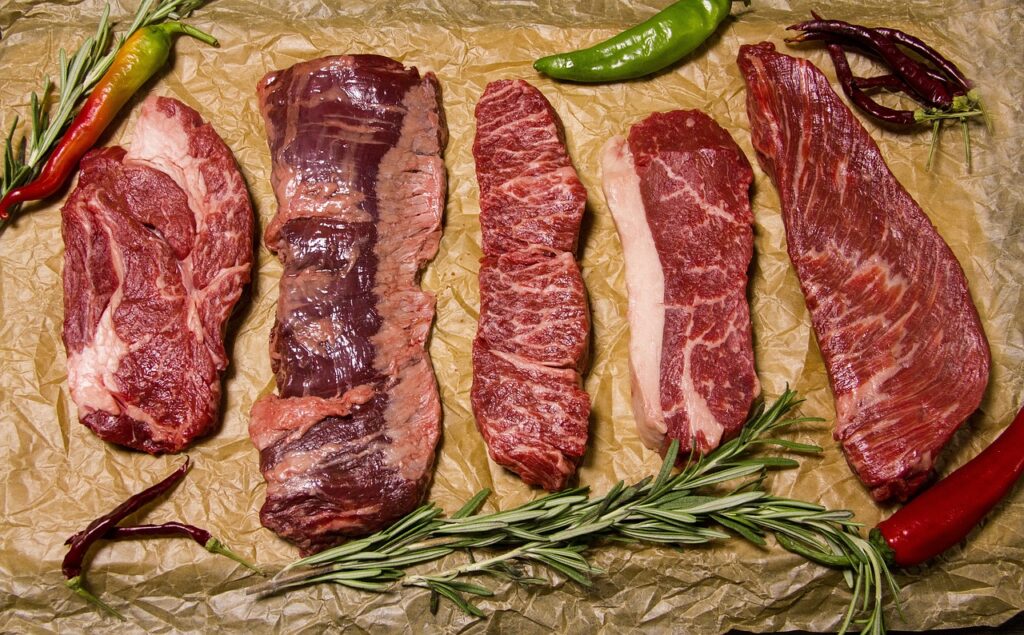Are you considering the Carnivore Diet or the Keto Diet but not sure which one is right for you? In this blog post, we’ll explore the benefits and differences between these two popular diets. From understanding what each diet entails to comparing their effects on weight loss and overall health, we’ll help you make an informed decision about which approach aligns best with your goals. So let’s dive in and discover whether a carnivorous lifestyle or a ketogenic journey suits you better!
1. What is the Carnivore Diet?

The Carnivore Diet is a dietary approach that focuses on consuming exclusively animal foods. It is characterized by high fat and protein intake, with little to no carbohydrates from plant-based sources. This diet primarily consists of meat products, such as beef, poultry, and seafood.
The Carnivore Diet completely eliminates all plant-based foods, focusing solely on animal products like meat, poultry, and seafood. This strict approach provides a rich source of essential amino acids and vitamins found in meat.
Unlike the ketogenic (keto) diet which allows for some carbohydrates from low-carb vegetables and certain fats like avocado oil or coconut oil, the carnivore diet strictly eliminates all plant-based foods. The emphasis on animal products provides a rich source of nutrients, including essential amino acids and vitamins found in meat.
1.1 Basic principles of the Carnivore Diet
No plant-based foods allowed in the Carnivore Diet. The diet focuses exclusively on consuming animal products, such as meat. Carbohydrates and high-fiber foods are eliminated from the diet in order to promote fat and protein intake.
1.2 Potential benefits of the Carnivore Diet
- Weight loss and improved body composition: The Carnivore Diet, which focuses on consuming primarily meat and animal products, can lead to weight loss and improved body composition due to its high protein content that promotes satiety and helps preserve lean muscle mass while burning fat.
- Increased energy levels: By eliminating processed foods and carbohydrates commonly found in a standard diet, the Carnivore Diet provides a steady source of energy through nutrient-dense meats. This can result in increased energy levels throughout the day without experiencing crashes or fluctuations often associated with sugar or carb-laden meals.
- Reduced inflammation: The strict elimination of inflammatory foods such as grains, legumes, and certain vegetables makes the Carnivore Diet potentially beneficial for individuals struggling with chronic inflammation. A focus on high-quality meat sources rich in omega-3 fatty acids may help reduce inflammation markers within the body.
1.3 Possible risks and drawbacks of the Carnivore Diet
- Nutrient deficiencies due to limited food variety: The carnivore diet mainly consists of meat, which may result in inadequate intake of essential nutrients found in fruits, vegetables, and grains.
- ‘Keto flu’ symptoms during adaptation phase: When transitioning to a low-carbohydrate diet like the carnivore diet, some individuals may experience temporary side effects such as fatigue, headaches, and irritability.
- Long-term sustainability concerns: Relying heavily on animal products for an extended period can lead to environmental issues related to excessive consumption of meat. Additionally, maintaining this dietary pattern over time might be challenging for some individuals due to taste preferences or concerns about saturated fat intake.
Overall Title: Carnivore Diet vs Keto: Comparing the Benefits and Differences
2. What is the Keto Diet?
The Keto Diet, short for Ketogenic Diet, is a low-carb, high-fat diet that aims to put your body into a state of ketosis. This metabolic state occurs when your body doesn’t have enough carbohydrates to burn for energy and starts using fat instead.
In the Keto Diet, you primarily consume foods that are high in healthy fats like avocados and olive oil while limiting your intake of carbohydrates from sources such as grains and sugars. This way, your body switches its main fuel source from glucose to ketones produced by breaking down fats. The goal is to promote weight loss, increased energy levels, improved mental clarity, and better blood sugar control.
2.1 Basic principles of the Keto Diet
Macronutrient ratio: The Keto Diet is characterized by a high fat, moderate protein, and low carb macronutrient ratio. This means that the majority of calories consumed come from fats, followed by proteins, with minimal intake of carbohydrates.
Ketosis as the main goal: Ketosis is a metabolic state in which the body primarily relies on ketones for energy instead of glucose. The Keto Diet aims to induce and maintain this state of ketosis through its specific macronutrient composition.
Limited carb intake: One key principle of the Keto Diet is restricting carbohydrate consumption to a very low level. By limiting carb intake, the body is forced to turn to stored fat as its primary source of fuel, leading to weight loss and enhanced fat burning capabilities.
- High-fat
- Moderate-protein
- Low-carb
2.2 Potential benefits of the Keto Diet
Weight loss and fat burning: The Keto Diet promotes weight loss by inducing a state of ketosis, where the body burns stored fat for energy instead of carbohydrates. By limiting carbohydrate intake and increasing healthy fats, the diet helps to reduce cravings and control appetite.
Improved mental clarity and focus: The Keto Diet has been shown to enhance cognitive function by providing a steady supply of ketones as an alternative fuel source for the brain. This can result in improved mental clarity, increased focus, and better overall cognitive performance.
Reduced inflammation: Following the Keto Diet has been linked to reduced levels of inflammation in the body. Ketones produced during ketosis have anti-inflammatory properties that can help alleviate symptoms associated with conditions such as arthritis or autoimmune disorders.
2.3 Possible risks and drawbacks of the Keto Diet
During the adaptation phase of the Keto Diet, some individuals may experience what is known as “keto flu,” which includes symptoms such as fatigue, headache, and nausea. It is important to be aware of this potential side effect and take proper measures to alleviate discomfort during this period.
Another risk associated with the Keto Diet is nutrient deficiencies if not properly balanced. Since carbohydrates are significantly restricted in this diet, it can be challenging to obtain essential nutrients like fiber, vitamins, and minerals from other food sources. Therefore, careful planning and supplementation may be necessary to ensure adequate nutrition.
Lastly, it’s worth noting that the restrictive nature of the Keto Diet can make it difficult for some individuals to maintain long-term adherence. The elimination or severe limitation of certain food groups may lead to feelings of deprivation or monotony over time. It’s important for those considering this diet to assess their ability to sustain such restrictions before committing fully.
3. Comparing the Carnivore Diet and Keto
3.1 What types of foods are allowed on the keto diet?

When following the keto diet, it is essential to adhere to specific guidelines regarding the types of foods allowed. Here are some foods that are typically permitted on the keto diet:
Low-carb vegetables: Non-starchy vegetables such as spinach, kale, broccoli, cauliflower, zucchini, and peppers are excellent options as they are low in carbs and high in nutrients.
Meat and poultry: Beef, chicken, turkey, pork, and other forms of unprocessed meat are suitable for the keto diet. Opt for grass-fed and organic options whenever possible to ensure higher-quality nutrients.
Seafood: Fish and shellfish like salmon, trout, tuna, shrimp, and crab are keto-friendly choices due to their high protein and healthy fat content. Additionally, they are rich in omega-3 fatty acids, which offer numerous health benefits.
Eggs: Eggs are versatile and can be included in various keto recipes. They are an excellent source of protein, healthy fats, vitamins, and minerals.
Healthy fats and oils: Avocado, olive oil, coconut oil, and butter are examples of healthy fats that are commonly used in the keto diet. These fats provide energy and help keep you feeling full.
Dairy products: Full-fat dairy products, such as cheese, butter, and heavy cream.
3.2 Similarities between the Carnivore Diet and Keto
Emphasizing high-fat consumption is a common feature of both the Carnivore Diet and Keto. Both diets prioritize the intake of healthy fats, such as avocados, nuts, and fatty cuts of meat. This emphasis on fats helps to provide sustained energy and promote satiety.
Promoting ketosis as a metabolic state is another shared characteristic between the Carnivore Diet and Keto. By restricting carbohydrate intake, both diets encourage the body to enter into a state of ketosis, where it relies on stored fat for fuel instead of carbohydrates. This can lead to improved weight loss and increased mental clarity.
Both the Carnivore Diet and Keto restrict the intake of carbohydrates. By minimizing or eliminating foods like grains, legumes, fruits, and starchy vegetables from their meals, followers are able to keep their carbohydrate levels low enough to maintain ketosis.
3.3 Differences between the Carnivore Diet and Keto
Variety of food sources allowed: The Carnivore Diet strictly limits the consumption to meat only, while the Keto diet includes non-meat options such as vegetables and dairy products.
Level of carbohydrate restriction: The Carnivore Diet follows an extremely low-carbohydrate approach, whereas the Keto diet allows for a moderate to low intake of carbohydrates.
Focus on nutrient density: The Carnivore Diet heavily relies on animal products for essential nutrients, whereas the Keto diet can incorporate a wider range of plant-based sources alongside animal products.
4. Which Diet is Right for You?
When deciding between the Carnivore Diet and Keto, there are several factors to consider. Both diets emphasize low carbohydrate intake, but the Carnivore Diet focuses solely on animal products while Keto allows for a wider range of food choices including non-animal sources such as vegetables and fruits.
Personal preferences and goals also play a crucial role in choosing the right diet. If you enjoy consuming meat exclusively and want to experience potential benefits like improved energy levels and weight loss, then the Carnivore Diet might be suitable for you. On the other hand, if you prefer a more flexible approach that includes plant-based foods alongside meats, or if your goal is long-term sustainability rather than immediate results, then Keto could be a better fit.
While it’s important to explore different diets on your own, consulting with a healthcare professional can provide valuable insights tailored to your specific needs. They can help assess any underlying health conditions or concerns before making an informed decision about which diet aligns best with your overall well-being.
Remember that choosing the right diet involves careful consideration of various factors such as personal preference, goals, and consultation with professionals who can offer guidance based on individual circumstances. By taking these aspects into account when comparing the Carnivore Diet to Keto, you’ll be able to make an informed decision that supports both your short-term objectives and long-term health journey.
4.1 Factors to consider when choosing between the Carnivore Diet and Keto
Factors to Consider When Choosing Between the Carnivore Diet and Keto:
Nutrient Variety: The carnivore diet focuses mainly on animal products, lacking in variety of nutrients compared to the keto diet which includes a wider range of foods like vegetables and healthy fats.
Sustainability: While both diets can lead to weight loss, sustainability may be a concern with the carnivore diet due to its restrictive nature, making it harder to maintain in the long term compared to the more flexible keto approach.
Health Conditions: Individuals with certain health conditions such as cardiovascular disease or diabetes should consult with a healthcare professional before starting either diet as they may require modifications or monitoring based on specific needs.
Individual Tolerance: Each person’s body reacts differently, so it’s important to listen to your own body’s signals when choosing between these two diets and finding what works best for you personally.
Personal Preferences and Goals: Consider your personal food preferences, lifestyle factors, and goals when deciding between these two diets – whether you prioritize quick weight loss or overall health improvement.
Long-Term Effects: Research is still ongoing regarding potential risks associated with both diets over an extended period of time; therefore, considering current evidence is crucial before committing fully
Remember that making informed decisions about dietary choices requires careful consideration of individual needs and health circumstances; consulting with a healthcare professional is essential for personalized guidance tailored specifically for your unique situation
4.2 Personal preferences and goals
Personal preferences and goals play a crucial role in determining whether the Carnivore Diet or Keto is more suitable for an individual. It is important to consider factors such as taste preferences, desired weight loss or maintenance, and overall health objectives.
- Taste preferences may influence one’s choice between the two diets
- People seeking rapid weight loss may find success with either diet
- Individuals aiming for long-term sustainability might prefer the Keto approach
- Those with specific health conditions should consult with a healthcare professional before embarking on any dietary changes
4.3 Consulting with a healthcare professional

Before embarking on either the Carnivore Diet or the Keto diet, it is crucial to consult with a healthcare professional. They can assess your individual health needs and provide informed guidance tailored to your specific circumstances. This step is especially important if you have any underlying medical conditions or are taking medications that may be affected by dietary changes. By seeking expert advice, you can ensure that you make an informed decision that prioritizes both your health and overall well-being.
In addition, consulting with a healthcare professional allows for monitoring and support throughout your journey on either the Carnivore Diet or Keto diet. They can help track any potential side effects or deficiencies in nutrients as well as provide appropriate adjustments to optimize results while minimizing risks. Remember, their expertise will greatly contribute to ensuring a safe and effective transition into whichever dietary approach aligns best with your goals and preferences.
(Note: These paragraphs assume prior information regarding the benefits of consulting with a healthcare professional when considering dietary changes.)
5. Conclusion
In conclusion, both the carnivore diet and the keto diet offer unique benefits and differences. The carnivore diet provides a more restrictive approach by eliminating all plant-based foods, while the keto diet focuses on reducing carbohydrates and increasing healthy fats. Both diets have shown potential for weight loss, improved energy levels, and better blood sugar control. However, it’s important to consider individual preferences and nutritional needs when choosing between these two approaches.
Ultimately, whether you decide to follow a carnivore or keto diet depends on your personal goals, dietary preferences, and overall health status. Consulting with a healthcare professional or registered dietitian is advisable before making any significant changes to your eating habits. Remember that everyone’s body is different, so finding what works best for you is key in achieving long-term success in maintaining optimal health.


